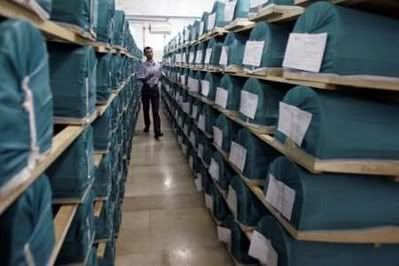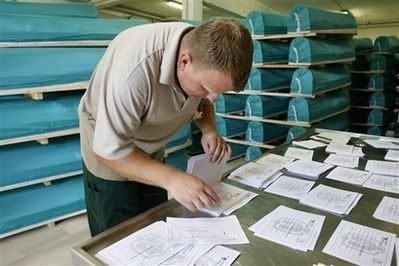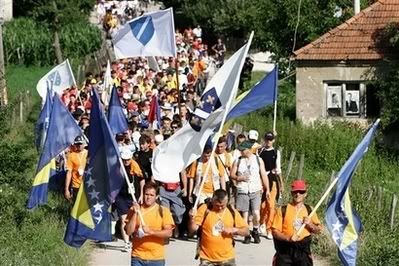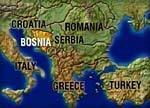 SREBRENICA, Bosnia (July 8,2008) – The remains of 307 Bosnian civilians murdered by the genocidal Serbin fascist aggressor in the eastern Bosnian town of Srebrenica in 1995 will be buried on July 11 on the anniversary of Europe’s worst atrocity since World War II, organisers said yesterday.The funeral is to be held at the site where some 10,000 Bosnian civilians were mass murdered by the genocidal Serbian fascist aggressor in July 1995.The bodies of genocide victims were exhumed from mass graves after the end of the 1992-1995 Serbian aggression against Bosnia and have been identified by DNA analysis. The genocide victims were aged between 15 and 75.
SREBRENICA, Bosnia (July 8,2008) – The remains of 307 Bosnian civilians murdered by the genocidal Serbin fascist aggressor in the eastern Bosnian town of Srebrenica in 1995 will be buried on July 11 on the anniversary of Europe’s worst atrocity since World War II, organisers said yesterday.The funeral is to be held at the site where some 10,000 Bosnian civilians were mass murdered by the genocidal Serbian fascist aggressor in July 1995.The bodies of genocide victims were exhumed from mass graves after the end of the 1992-1995 Serbian aggression against Bosnia and have been identified by DNA analysis. The genocide victims were aged between 15 and 75.Some 2,900 genocide victims from Srebrenica have been buried so far at the Genocide Memorial Centre built in 2003,near Srebrenica but thousands of others are yet to be exhumed and identified. More than 60 mass graves have been uncovered in the area.
Meanwhile, forensic experts have found another mass grave near Srebrenica,the Bosnian national radio reported. The 17m long grave is outside the village of Zeleni Jadar, about 15km south of Srebrenica. Exhumation is to be completed in two weeks.
The site is the eighth of what are known as the secondary graves to be found in Zeleni Jadar, where the genocidal Serbian fascist aggressor brought bodies of the genocide victims to cover up the massacre.
Previously exhumed sites contained the remains of several hundred genocide victims. Remains were reburied by bulldozers, so most of the skeletons were incomplete which makes DNA identification process very difficult.

A Bosnian worker inspects coffins containing the bodies of 307 newly-identified genocide victims from Srebrenica for a joint burial near the Bosnian town of Visoko. Each year, bones are matched to a name and buried in a mass funeral on July 11, the anniversary of the genocide committed by the Serbian fascist aggressor,during the 1992-1995 Serbian aggression against Bosnia.

A Bosnian worker at city morgue in the central Bosnian town of Visoko, on Monday, July 7, 2008, sorts paperwork for 307 bodies of the genocide victims prepared to be transported and buried at their final resting place at the Genocide Memorial Centre in Potocari near Srebrenica. All 307 bodies of the genocide victims were excavated from mass graves in eastern Bosnia and identified by teams of Bosnian and international forensic experts. The burial ceremony will be held on 11 July, 2008, in Srebrenica, on the 13th anniversary of the genocide in this part of Bosnia when the genocidal Serbian fascist aggressor's mass murdered some 10,000 Bosnian civilians.

A Bosnian woman, a genocide survivor from Srebrenica, reads the names of Bosnian civilians mass murdered by the genocidal Serbian fascist aggressor in the former U.N. safe zone of Srebrenica as she visits the Genocide Memorial Centre in Potocari,near Srebrenica.
The Srebrenica massacre has been classified as an act of genocide by the International Court of Justice and the UN war crimes tribunal, both based at The Hague.
The masterminds of the genocide in Bosnia - Serbian war criminals Radovan Karadzic and Ratko Mladic - are still hiding from justice,protected by the genocidal Serbia.
Friday’s commemoration of the genocide, at which tens of thousands of Bosnians are expected, comes amid warnings of possible violence after a recent UN court ruling.
Last week, a UN appeals court acquitted the former commander of the Bosnian Army units in the eastern Bosnian town of Srebrenica Naser Oric of all war crimes charges including the killings of six genocidal Serbian fascist aggressor's soldiers captured and held by the Bosnian Army in 1992 and 1993 in Srebrenica.
.







